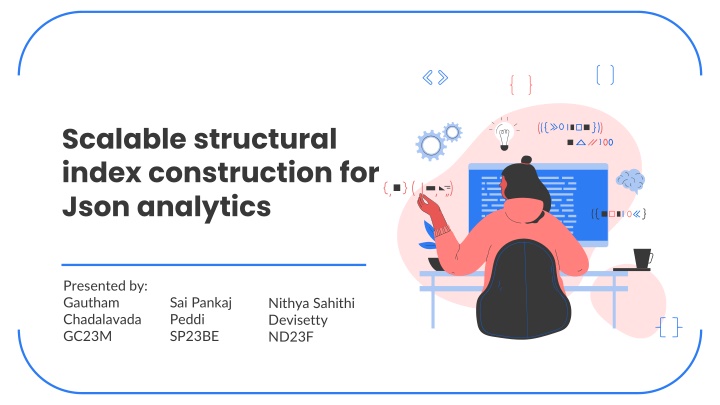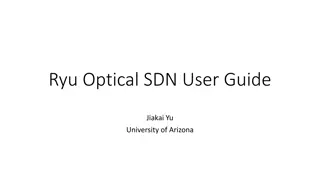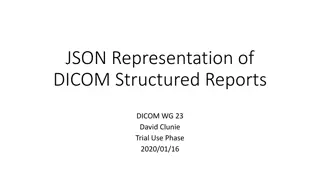
Efficient Java-native Structural Indexing System for JSON Analytics
"Discover how a Java-native structural indexing system, inspired by Pison, accelerates JSON analytics by avoiding full deserialization. Learn about the motivations, project overview, and implementation strategies for high-performance JSON processing."
Download Presentation

Please find below an Image/Link to download the presentation.
The content on the website is provided AS IS for your information and personal use only. It may not be sold, licensed, or shared on other websites without obtaining consent from the author. If you encounter any issues during the download, it is possible that the publisher has removed the file from their server.
You are allowed to download the files provided on this website for personal or commercial use, subject to the condition that they are used lawfully. All files are the property of their respective owners.
The content on the website is provided AS IS for your information and personal use only. It may not be sold, licensed, or shared on other websites without obtaining consent from the author.
E N D
Presentation Transcript
Scalable structural index construction for Json analytics Presented by: Gautham Chadalavada GC23M Sai Pankaj Peddi SP23BE Nithya Sahithi Devisetty ND23F
Table of contents Introduction Motivation What is Pison? Project Overview System Architecture Implementation and Experimental Conclusion
Introduction Modern applications rely heavily on JSON for data exchange but parsing large and deeply nested JSON structures is CPU and memory intensive. Traditional JSON parsers like Jackson or GSON perform sequential, full-deserialization, making them inefficient for large-scale analytics. There s a growing need for high-performance, structure-aware parsing systems that avoid full deserialization and enable fast querying. This project aims to implement a Java-native structural indexing system, inspired by Pison (C++), to achieve scalable, parallel, and memory-efficient JSON processing.
Motivation Traditional JSON parsers like Jackson or GSON rely on sequential, full deserialization a major bottleneck for large-scale or deeply nested JSON data. As data volumes grow, these parsers become memory-intensive and CPU-bound, leading to poor performance in real-time analytics pipelines. Native solutions like simdjson and Mison offer high-speed parsing but are C++-based and require JNI for Java integration, which adds complexity and overhead. There is a clear need for a high-throughput, memory-efficient JSON parsing system that is native to Java and leverages SIMD, parallelism, and off-heap memory.
What is Pison? Pison is a high-performance C++ system that accelerates JSON analytics by avoiding full deserialization and building structural indices. It uses SIMD instructions to scan JSON data in parallel, identifying structural characters like and , across multiple bytes at once. Pison constructs bitmaps representing JSON structure and applies speculative parsing followed by a rectification pass to eliminate false positives. This approach enables fast, memory-efficient querying directly over raw JSON, achieving 2x 4x speedups compared to traditional parsers.
Project Overview This project implements a Java-native structural indexing system for JSON parsing, performance C++ system, Pison. inspired by the high- It constructing SIMD-accelerated structural indices directly from raw JSON input. eliminates the need for full deserialization by The system leverages Java s Vector API, off-heap memory via sun.misc.Unsafe, and ForkJoinPool-based parallelism for scalability and low-latency execution. The goal is to deliver a high-throughput, memory-efficient, and portable solution suitable for enterprise-grade Java environments without relying on JNI.
Implementation and Experimentation The system is implemented entirely in Java 21, leveraging the Vector API for SIMD-based character scanning and ForkJoinPool for parallel task execution. Structural Index Construction involves scanning raw JSON input using 256-bit SIMD vectors to detect structural characters (:, ,, {, }) and encoding their positions into off-heap bitmaps via sun.misc.Unsafe. Parsed JSON is divided into entropy-aware chunks that are dynamically scheduled to threads using a work- stealing ForkJoinPool, enabling intra-record parallelism. The query engine operates directly over the structural index, evaluating path-based queries (e.g., JSONPath- style) without full deserialization. For evaluation, we used real-world JSON datasets from GitHub Archive and StackOverflow Dumps, along with synthetic datasets for stress-testing. Benchmarks were run using JMH to measure parsing throughput, memory usage, and scaling behavior.
Evaluation of Success Parsing Throughput (MB/s) Off-Heap Memory Efficiency Thread-Level Scalability Query Latency Over Indexed Paths
Conclusion Proposed a Java-native structural indexing system inspired by Pison for scalable JSON analytics. Uses SIMD, off-heap memory, and parallelism to avoid full deserialization. Fully JVM-integrated, removing the need for JNI or native bindings. Aims to improve parsing speed, memory efficiency, and scalability for large JSON workloads.






















